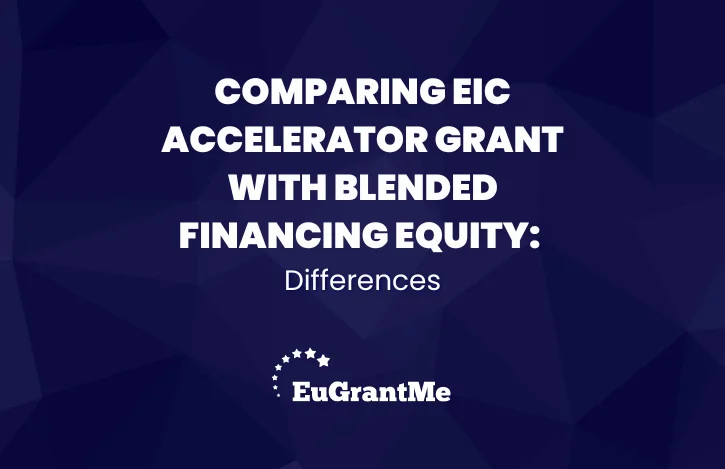The European Innovation Council (EIC) Accelerator is known for offering various funding schemes. These include the EIC Accelerator grant and blended financing equity. Understanding the differences between these two funding options is essential for applicants. It ensures alignment between the company’s growth strategy and the type of financial support pursued. This article delves into the distinct features of EIC Accelerator financing and provides guidance on selecting the best approach for your business.
Overview of EIC Accelerator Grant
The EIC Accelerator grant is a non-dilutive funding option. It aims to support innovative projects at the early stages of development. Grants cover up to 70% of eligible costs. They are primarily used for activities such as feasibility studies, prototype development, and initial market deployment. Companies receive financial support without giving away any equity. This allows them to retain full ownership and control of their business.
Key Benefits of the EIC Accelerator Grant
One of the main advantages of the EIC Accelerator grant is its non-dilutive nature. It is especially beneficial for start-ups and SMEs aiming to establish their market presence without compromising ownership. This funding enables companies to develop and test their innovations, reduce technological risks, and create a robust go-to-market strategy.
The grant is suitable for projects that require validation before securing additional funding. It also facilitates collaborations with research institutions, providing access to knowledge and expertise that might otherwise be difficult to obtain.
Understanding Blended Financing Equity
Blended financing equity, on the other hand, combines grant funding with equity investment. This approach is tailored for projects with higher potential but greater risk. The equity portion involves an investment by the EIC Fund. This provides companies with additional financial resources to scale up and accelerate commercialisation.
Differences Between EIC Accelerator Grant and Blended Financing Equity
While the EIC Accelerator grant offers financial support without ownership dilution, blended financing includes an equity component. This means the EIC becomes a shareholder in the company. As a result, companies benefit from increased funding, which can be pivotal for scaling operations and expanding market reach.
Another difference lies in the project stage each option targets. The grant is ideal for early-stage projects, while blended financing is more suited for companies seeking to transition to a growth phase. Companies applying for blended financing should be prepared to share information about their financial health and future projections. This transparency is crucial for equity investors to evaluate the company’s long-term viability.
Suitability of EIC Accelerator Grant for SMEs
The EIC Accelerator grant is particularly appealing to SMEs in the research and development (R&D) stage. It allows these companies to focus on innovation without the added pressure of equity dilution. SMEs benefit from the flexibility to explore partnerships, develop their technology, and test the market. At the same time, they remain attractive to potential investors, as no equity has been given up.
Strategic Implications of Non-Dilutive Funding
Non-dilutive funding has strategic advantages. It preserves the company’s capital structure and reduces the need for external negotiations. For SMEs, this can lead to a stronger bargaining position when negotiating follow-on investments. Additionally, securing a grant from a prestigious programme like the EIC Accelerator can enhance a company’s credibility. It signals to future investors that the company has passed rigorous selection criteria.
Advantages of Blended Financing Equity for Growth-Oriented Companies
Blended financing equity is a compelling option for companies ready to scale. It provides the necessary capital to cover high growth costs such as manufacturing, marketing, and international expansion. With the EIC as a shareholder, companies also gain access to strategic guidance and networking opportunities. This can accelerate market entry and foster strategic partnerships.
Equity Investment and Its Impact on Business Strategy
Accepting equity investment impacts a company’s strategic decisions. It introduces new stakeholders who may influence decision-making and corporate governance. However, it also brings substantial benefits, such as increased funding and reduced financial constraints. Companies with a clear vision and growth strategy can leverage this funding to achieve rapid development. The involvement of the EIC as a stakeholder can also make it easier to attract further private investment.
Decision Criteria for EIC Accelerator Financing Options
Selecting between an EIC Accelerator grant and blended financing equity depends on several factors. The company’s stage of development, financial needs, and long-term goals are crucial considerations. Companies seeking to validate their technology and gain market traction may find the grant more appropriate. Meanwhile, businesses ready to scale and accelerate their growth should consider blended financing.
Considerations for Grant Applications
For companies applying for the EIC Accelerator grant, a strong emphasis on technological innovation and market potential is essential. The project must demonstrate a high degree of novelty and a clear path to commercialisation. Grant applicants should also outline the societal impact of their project. This is because the EIC aims to support innovations that address global challenges.
Considerations for Blended Financing Applications
Blended financing applications require a detailed business plan and financial forecast. Companies must show how the additional equity investment will be used to achieve growth milestones. The ability to present a scalable business model and a strategy for revenue generation is key. Applicants should also be ready to engage in discussions about valuation, as this determines the terms of the equity investment.
Choosing between the EIC Accelerator grant and blended financing equity depends on your company’s development stage and funding needs. EIC Accelerator financing offers unique opportunities for companies to bring their innovations to market. For early-stage projects, the non-dilutive grant provides essential support while retaining ownership. For companies ready to scale, blended financing equity offers the resources and strategic guidance necessary for growth. Understanding these differences will help you align your application with your business strategy and maximise your chances of success.
At EuGrantMe, we are passionate about fostering innovation and empowering ambitious minds to flourish. Our mission revolves around providing top-notch grant writing services for the EIC Accelerator and Horizon grants in Europe. We enable our customers to unlock the full potential of their ground-breaking ideas.
Do you have a project to turn into reality?
Contact us!


